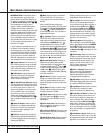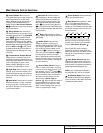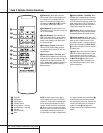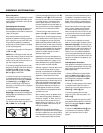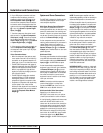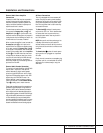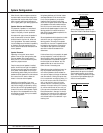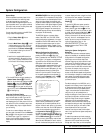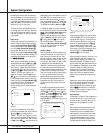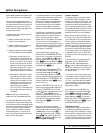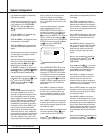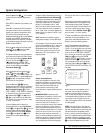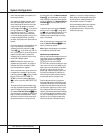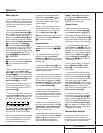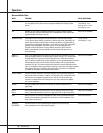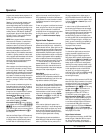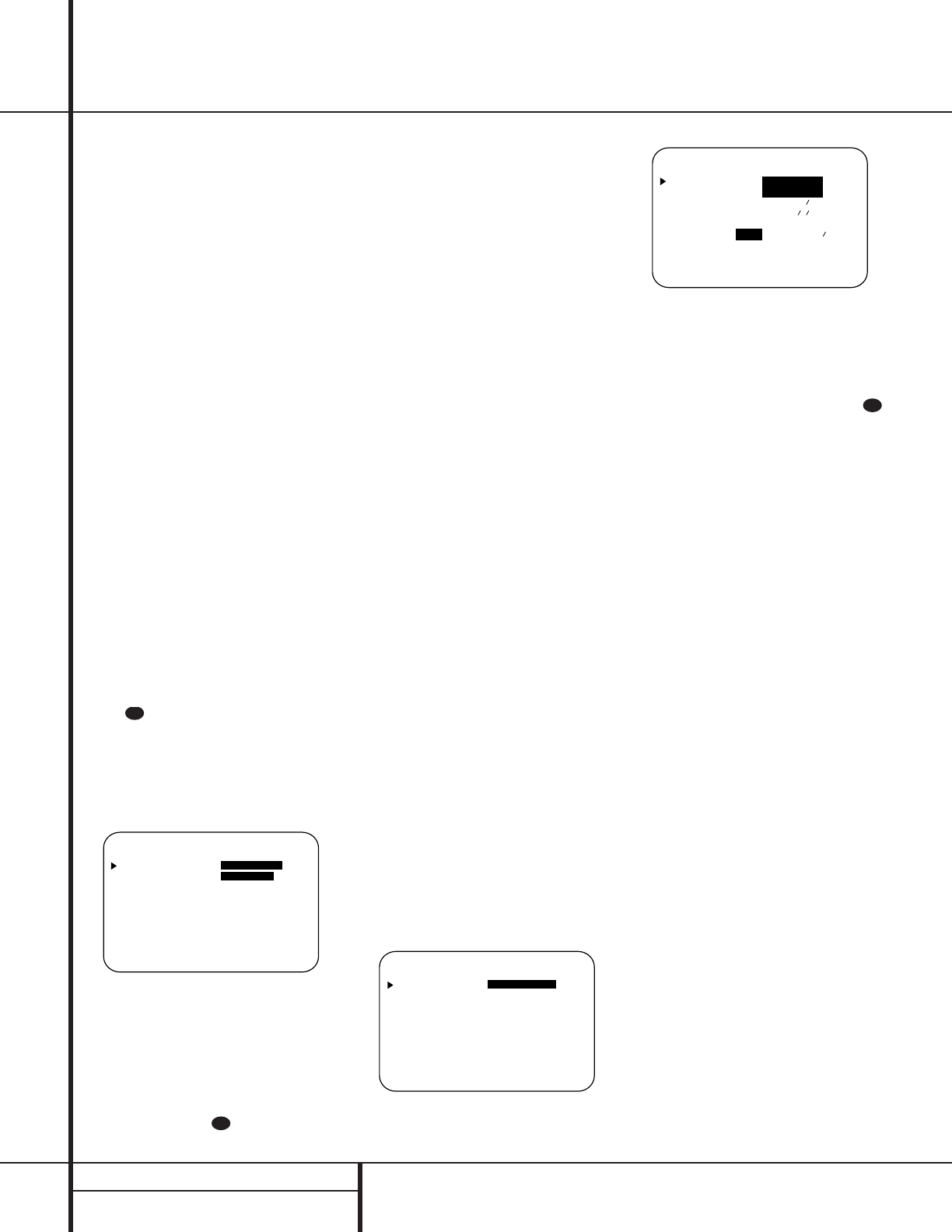
20 SYSTEM CONFIGURATION
System Configuration
the settings for the first input, many settings
may be duplicated for the remaining inputs. It is
also a good idea to set the configuration data
in the order these items are listed in the Main
Audio Setup Menu, as some settings require a
specific entry in a prior menu item.
The items that follow will describe the individ-
ual settings required for each input. Remember
that once the settings are made for one input,
they must be made for all other input sources
in your system.
Input Setup
The first step in configuring the AVR 7000 is to
select an input. This may be done by pressing
the front panel Input Source Selector !
until the desired input’s name appears momen-
tarily in the Main Information Display W,
and the green LED lights next to the input’s
name in the front panel Input Indicators Ó.
The input may also be selected by pressing the
appropriate Input Selector on the remote con-
trol bclmn.
When using the full-OSD system to make the
setup adjustments, press the OSD button s
once so that the main AUDIO SETUP
menu (Figure 1) appears. Note that the
›
cur-
sor will be next to the input setup line. Press
the Set button i to enter the menu and the
INPUT SETUP menu (Figure 2) will
appear on the screen. Press the
‹
/
›
buttons
j until the desired input name appears
in the highlighted video, as well as being indi-
cated in the front panel Input Indicators Ó
by the green LED next to the desired input
name. If the input will use the standard
left/right analog inputs, no further adjustment
is needed.
Figure 2
If you wish to associate one of the digital
inputs with the selected input source, press the
¤
button g on the remote while the
INPUT SETUP menu (Figure 2) is on the
screen, and note that the on-screen cursor will
drop down to the DIGITAL IN line. Press
the
‹
/
›
buttons j until the name of the
desired digital input name appears. To return to
the ANALOG input, press the buttons until
the word analog appears. When the correct
input source appears, press the
¤
button once
so that the
›
cursor appears next RETURN
TO MENU, and press the Set button i.
To change the digital input at any time using
the discrete function buttons and the semi-OSD
system, press the Digital Input Select button
k on the front panel or the remote.
Within five seconds, make your input selection
using the Selector buttons on the front panel
5 or the
⁄
/
¤
buttons g on the remote
until the desired digital or analog input is
shown in the Main Information Display W
and in the lower third of the video display
connected to the AVR 7000.
Surround Setup
Once the input setup has been completed, the
next step for that input is to set the surround
mode you wish to use with that input. Since
surround modes are a matter of personal taste,
feel free to select any mode you wish – you
may change it later. However, to make it easier
to establish the initial parameters for the
AVR 7000, it is best to select Dolby Pro Logic
for most analog inputs and Dolby Digital for
inputs connected to digital sources. In the case
of inputs such as a CD Player, Tape Deck or
Tuner, you may wish to set the mode to Stereo,
if that is your preferred listening mode for
standard stereo sources, where it is unlikely
that sur
round encoded material will be used.
Alternatively, the
Logic 7 Music mode may
also be a good choice for stereo-only source
material.
It is easiest to complete the surround setup
using the full-OSD on-screen menus. From the
MAIN AUDIO SETUP menu (Figure 1),
press the
‹
/
›
button g5 until the
›
cursor
is next to the SURROUND SETUP menu.
Press the Set button i( so that the
SURROUND SETUP menu (Figure 3 or 4)
is on the screen.
Figure 3
Figure 4
Since the factory default for all inputs is Stereo,
the words SURR OFF will initially appear in
highlighted video (Figure 3). To change the sur-
round mode while the
›
cursor is next to the
surround line, press the
‹
/
›
buttons j
until the desired surround mode’s name
appears in the highlighted video. As the modes
are changed, a green LED will also light next to
the mode names in the Surround Mode
Indicators ı on the front panel.
Note that the data lines next to the items in the
screen display will show either numbers or a
series of dashes, depending on whether or not
the specific parameter is adjustable. For exam-
ple, the Center Delay and Night Mode items are
only adjustable for Dolby Digital, and the Delay
Time is only adjusted for Dolby Digital and
Dolby Pro Logic. The Crossover Frequency is
adjustable in all modes. Note, also, that Dolby
Digital and DTS will only appear as choices
(Figure 4) when a digital input was previously
selected.
Depending on the surround mode selected, you
will now proceed to change either the delay
time or the crossover frequency. For Dolby
Digital and Dolby Pro Logic, pressing the
⁄
/
¤
buttons g5 will take you to the delay set-
tings, for all other modes, it will take you to the
Crossover Frequency adjustment.
Delay Settings
If Dolby Digital or Dolby Pro Logic is selected as
the surround mode for an input, you will need
to adjust the delay time setting. Note that the
delay time is not adjustable for any other
modes.
Due the different distances between the front
channel speakers and the listening position
compared to the surround speakers and the
listening position, the amount of time it takes
for sound to reach your ears from the front or
surround speakers is different. You may com-
pensate for this difference through the use of
the delay settings to adjust the timing for the
29
* SURROUND SETUP *
SURROUND: DOLBY
DIGITAL
CENTER DELAY: 0MS
SURR DELAY: 00MS
CROSSOVER FREQ: 90HZ
NIGHT: OFF MID MAX
RETURN TO MENU
* SURROUND SETUP *
SURROUND: SURR OFF
CENTER DELAY: MS
SURR DELAY: MS
CROSSOVER FREQ: 90HZ
NIGHT:
RETURN TO MENU
29
INPUT :VIDEO 1
DIGITAL IN:ANALOG
RETURN TO MENU
29



